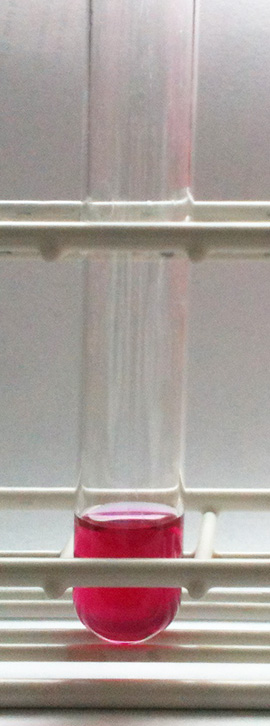Voges–Proskauer test
(Redirected from Voges-Proskauer test)
Voges–Proskauer test
The Voges–Proskauer test (VP test) is a biochemical test used to detect the presence of acetoin in a bacterial broth culture. It is one of the series of tests known as the IMViC tests, which are used to differentiate between members of the family Enterobacteriaceae.
Principle[edit | edit source]
The Voges–Proskauer test is based on the detection of acetoin, a neutral end product of glucose metabolism. When bacteria ferment glucose via the butanediol pathway, acetoin is produced. The test involves adding specific reagents to the bacterial culture, which react with acetoin to produce a red color, indicating a positive result.
Procedure[edit | edit source]
1. Inoculate a tube of MR-VP broth with the test organism. 2. Incubate the tube at 35-37°C for 24-48 hours. 3. After incubation, add 0.6 mL of 5% alpha-naphthol (Barritt's reagent A) and 0.2 mL of 40% potassium hydroxide (Barritt's reagent B) to the culture. 4. Shake the tube gently to mix the reagents. 5. Allow the tube to stand for up to 60 minutes. 6. Observe the color change. A red color indicates a positive result, while no color change or a copper color indicates a negative result.
Interpretation[edit | edit source]
- Positive result: Development of a red color within 60 minutes indicates the presence of acetoin, suggesting that the organism ferments glucose via the butanediol pathway. - Negative result: No color change or a copper color indicates the absence of acetoin, suggesting that the organism does not ferment glucose via the butanediol pathway.
Applications[edit | edit source]
The Voges–Proskauer test is primarily used in the identification and differentiation of Enterobacteriaceae and other Gram-negative bacteria. It is particularly useful in distinguishing between Escherichia coli (VP-negative) and Enterobacter species (VP-positive).
Related Pages[edit | edit source]
References[edit | edit source]
External Links[edit | edit source]
Search WikiMD
Ad.Tired of being Overweight? Try W8MD's NYC physician weight loss.
Semaglutide (Ozempic / Wegovy and Tirzepatide (Mounjaro / Zepbound) available. Call 718 946 5500.
Advertise on WikiMD
|
WikiMD's Wellness Encyclopedia |
| Let Food Be Thy Medicine Medicine Thy Food - Hippocrates |
Translate this page: - East Asian
中文,
日本,
한국어,
South Asian
हिन्दी,
தமிழ்,
తెలుగు,
Urdu,
ಕನ್ನಡ,
Southeast Asian
Indonesian,
Vietnamese,
Thai,
မြန်မာဘာသာ,
বাংলা
European
español,
Deutsch,
français,
Greek,
português do Brasil,
polski,
română,
русский,
Nederlands,
norsk,
svenska,
suomi,
Italian
Middle Eastern & African
عربى,
Turkish,
Persian,
Hebrew,
Afrikaans,
isiZulu,
Kiswahili,
Other
Bulgarian,
Hungarian,
Czech,
Swedish,
മലയാളം,
मराठी,
ਪੰਜਾਬੀ,
ગુજરાતી,
Portuguese,
Ukrainian
Medical Disclaimer: WikiMD is not a substitute for professional medical advice. The information on WikiMD is provided as an information resource only, may be incorrect, outdated or misleading, and is not to be used or relied on for any diagnostic or treatment purposes. Please consult your health care provider before making any healthcare decisions or for guidance about a specific medical condition. WikiMD expressly disclaims responsibility, and shall have no liability, for any damages, loss, injury, or liability whatsoever suffered as a result of your reliance on the information contained in this site. By visiting this site you agree to the foregoing terms and conditions, which may from time to time be changed or supplemented by WikiMD. If you do not agree to the foregoing terms and conditions, you should not enter or use this site. See full disclaimer.
Credits:Most images are courtesy of Wikimedia commons, and templates, categories Wikipedia, licensed under CC BY SA or similar.
Contributors: Prab R. Tumpati, MD


